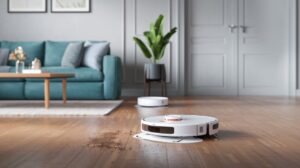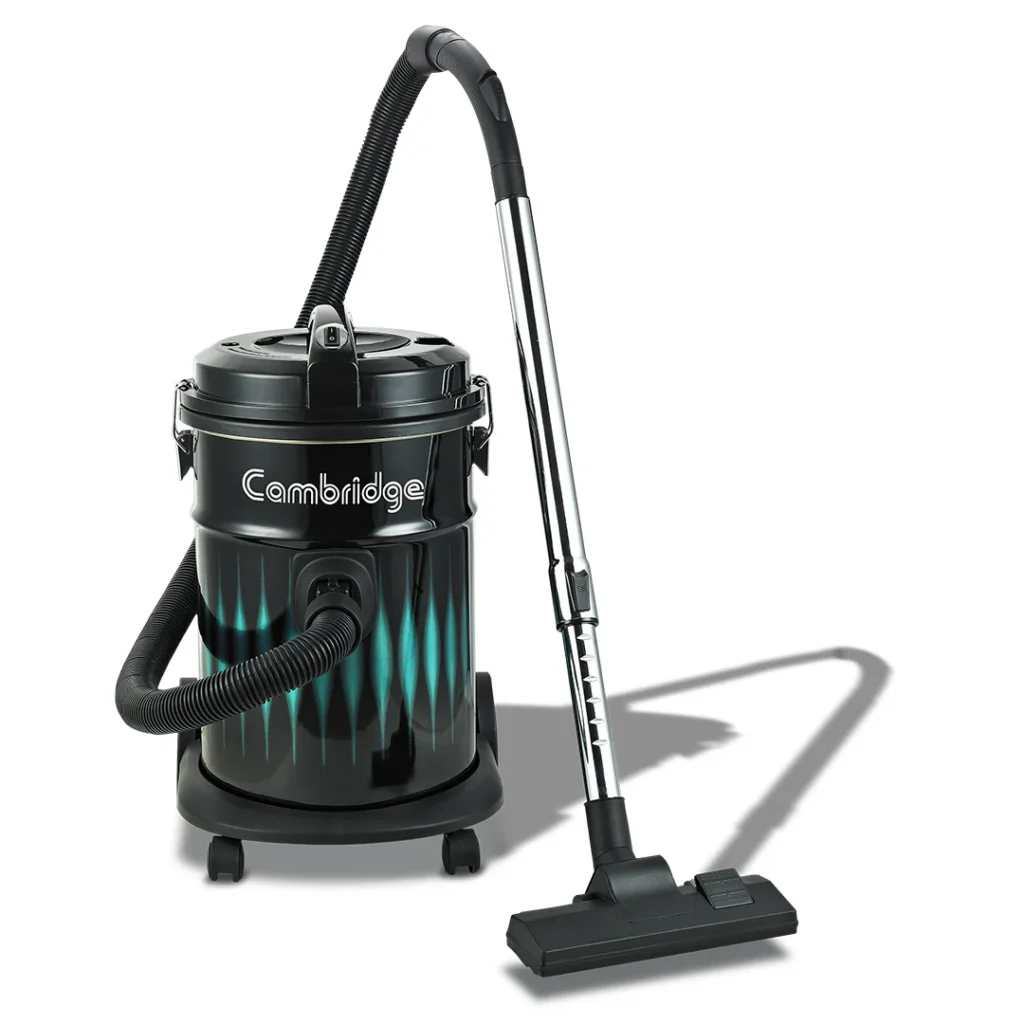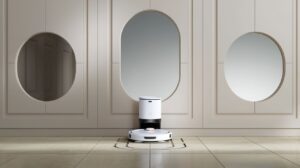As smart homes become an increasingly popular choice for homeowners, the integration of robotic vacuums is revolutionizing cleaning routines. A smart home robotic vacuum offers a convenient way to keep floors spotless without lifting a finger, especially when integrated with existing home automation systems.
These devices not only clean autonomously but can also be controlled remotely via smart home hubs or voice assistants like Alexa and Google Assistant.
Whether it’s setting schedules or starting a cleaning session with a simple voice command, the role of robotic vacuum integration in a smart home has never been more significant. Smart vacuum cleaners, equipped with advanced sensors and Wi-Fi capabilities, are designed to fit seamlessly into a connected home environment.
This technology allows users to optimize their cleaning schedules and even customize their robotic vacuum’s cleaning paths, enhancing overall efficiency. The convenience, ease of use, and automation that come with integrating a robotic vacuum into a smart home ecosystem make it an invaluable addition for many households.

2. What is a Robotic Vacuum?
A robotic vacuum is an automated cleaning device designed to vacuum floors with minimal human intervention. These self-operating vacuums have been around for a few years but have grown in popularity due to their innovative design and convenience. Unlike traditional vacuum cleaners, which require manual effort, a robotic vacuum with smart home integration brings cleaning to a whole new level by connecting seamlessly to your smart devices. It works autonomously, using advanced sensors and mapping systems to navigate around the home while ensuring that every corner is cleaned.
Definition and Basic Functions
At its core, a smart vacuum cleaner is a compact robotic device designed to clean floors through suction, brush systems, and intelligent navigation. These devices are typically smaller than traditional vacuum cleaners, making them ideal for tight spaces and areas under furniture. They come equipped with a variety of sensors that help them detect obstacles and dirt, enabling them to avoid collisions and focus on areas that need attention. The robotic vacuums can be programmed to clean at specific times, allowing users to set schedules based on convenience.
Many robotic vacuums also feature a self-charging function, meaning when their battery runs low, they can automatically return to their charging station. This feature ensures they are always ready for their next cleaning session, without any manual charging required. Some even come with self-emptying bins, so homeowners don’t need to worry about emptying the dustbin after every cleaning session.
Technological Features
What sets a robotic vacuum apart from a traditional one is its smart technology. A smart robotic vacuum is equipped with multiple features that make it more efficient and user-friendly. One of the standout features is advanced navigation systems, which enable the vacuum to map your home. This allows it to clean efficiently, avoid obstacles, and even adapt to different types of floors. It also helps the vacuum to learn your home layout, improving its cleaning path over time.
Another key feature of a smart robotic vacuum is Wi-Fi connectivity. With this feature, users can remotely control their robotic vacuums from a smartphone or tablet. Some robotic vacuums are compatible with voice assistants like Alexa or Google Assistant, which allows users to issue cleaning commands with just a voice prompt. This seamless integration into a smart home ecosystem enhances user convenience by enabling users to control their vacuums along with other smart home devices.
The robotic vacuums also include cleaning modes that can be customized according to the specific needs of a room. Whether you need a deep clean or a quick sweep, these vacuums can adjust the suction power, cleaning path, and more based on the task at hand. The ease with which these devices can be programmed or controlled remotely is a significant reason why they are considered the future of home cleaning.
How Robotic Vacuums Fit into the Smart Home Ecosystem
The integration of robotic vacuums into a smart home system allows for an even higher level of control and automation. For instance, a robotic vacuum with Alexa integration can be controlled using voice commands, allowing users to start, pause, or stop a cleaning session without lifting a finger. Similarly, robotic vacuums with Google Assistant can be set to start cleaning or return to their charging dock through simple voice interactions. This compatibility with voice assistants makes cleaning effortless and hands-free.
Another key element of the integration is the use of mobile apps. Many robotic vacuums come with their own apps that allow users to schedule cleanings, monitor cleaning progress, and receive maintenance alerts. These apps are also a gateway to advanced features, such as setting virtual boundaries, creating custom cleaning schedules, or even controlling the vacuum from anywhere, no matter where the user is. Wi-Fi enabled robotic vacuums also provide real-time updates, so users can track their vacuum’s progress and intervene if necessary.
Some advanced robotic vacuums integrate with other smart home appliances like smart lights and smart thermostats. For example, a vacuum might pause its cleaning cycle if it detects a room with a door that’s been left open, or it may adjust its cleaning schedule based on the presence or absence of people at home. These integrations ensure that cleaning is as efficient and personalized as possible.
3. The Role of Smart Home Integration</strong>
In today’s connected world, the role of smart home integration in robotic vacuums is a game-changer. A robotic vacuum with smart home integration allows users to connect their cleaning device with other smart devices in the home, transforming it from a simple vacuum into a powerful automation tool. By syncing with other smart home devices, the robotic vacuum offers unprecedented convenience, efficiency, and control. Let’s dive deeper into what this integration means for homeowners and how it enhances the vacuum’s performance.
What Does “Smart Home Integration” Mean?
Smart home integration refers to the process of connecting various devices within a home to work together through a centralized system, such as a smartphone app or smart hub. In the case of robotic vacuums, this integration allows them to communicate with other smart home appliances like thermostats, lights, and security systems, creating a seamless and efficient living environment.
When a robotic vacuum is integrated into a smart home system, it becomes more than just a cleaning tool. It becomes part of a broader ecosystem where multiple devices work in tandem. For instance, a Wi-Fi enabled robotic vacuum can be controlled via a mobile app or connected to a voice assistant like Alexa or Google Assistant for hands-free operation. With this level of control, users can start cleaning sessions, schedule cleanings, or even direct the vacuum to specific areas of their homes through simple voice commands.
Beyond basic functionality, smart home integration with robotic vacuums unlocks advanced features that make cleaning easier and more efficient. For example, a robotic vacuum with Alexa integration can be used in combination with other Alexa-enabled devices to create routines or automations. If the house is empty, users can command the vacuum to begin cleaning as soon as they leave the door, ensuring that they come back to a clean home. Similarly, when a robotic vacuum with Google Assistant is connected, users can take advantage of Google’s smart routines to control cleaning times based on their schedules.
The true value of robotic vacuums shines through when considering the benefits of automation and interconnectivity. With smart home integration, cleaning tasks become automated, saving users time and effort. This is especially useful for busy families, professionals, or anyone looking to simplify their home maintenance.
Automation allows users to set schedules and routines for their robotic vacuums, freeing them from having to remember to start or stop the cleaning process. Whether it’s setting the vacuum to clean while away at work or scheduling it for overnight cleaning, smart home integration makes it easy to incorporate cleaning into a busy lifestyle. For instance, a robotic vacuum with smart home integration can be scheduled to start cleaning when the house’s smart thermostat adjusts to an ideal temperature or when the lights go off for the night. These automation triggers help ensure that cleaning happens without any intervention, maximizing efficiency.
Moreover, interconnectivity ensures that the robotic vacuum works in tandem with other devices in the smart home. It’s not just about cleaning; it’s about optimizing the home environment. Imagine this scenario: the robotic vacuum is integrated with a smart thermostat, which can detect when no one is home. Once the home reaches a designated temperature, the vacuum begins its cleaning session. Or consider when the vacuum is paired with smart lights: as it finishes cleaning one room, the lights in that room turn off, indicating that the room is complete, while the lights in the next room turn on, signaling the vacuum to move forward.
Furthermore, robotic vacuums with Wi-Fi connectivity and voice assistants add another layer of convenience. Users can check in on their cleaning device from anywhere in the world using their mobile app or voice commands. This level of flexibility ensures that cleaning can be managed at any time, even if users are out of the house or relaxing on the couch.
Smart home integration also enhances the vacuum’s ability to perform more intelligent cleaning. Through apps and other connected devices, users can monitor the vacuum’s progress, adjust settings, and even receive alerts about the vacuum’s maintenance needs. For instance, the vacuum can alert you when the dustbin is full or when it needs a filter replacement. With this level of information, cleaning becomes a hassle-free experience.

4. Popular Smart Home Platforms and How They Connect</h3>
In the world of smart home integration, several platforms facilitate the connection between various devices, including robotic vacuums. These platf
orms allow homeowners to control and monitor their devices from one central location, streamlining their automation experience. When integrated with a robotic vacuum, these platforms provide the ultimate convenience, enabling users to start, stop, and schedule cleaning sessions effortlessly. Below, we explore the most popular smart home platforms and how they connect with robotic vacuums.
Voice Assistants and Smart Speakers (Alexa, Google Assistant, Siri)
One of the most popular and user-friendly methods of controlling a robotic vacuum is through voice assistants like Alexa, Google Assistant, and Siri. By integrating a robotic vacuum with Alexa, users can easily give voice commands to start, pause, or stop the cleaning cycle without lifting a finger. These voice commands allow the vacuum to become part of a hands-free cleaning routine, seamlessly fitting into the user’s day-to-day activities.
Google Assistant also offers similar functionality, enabling users to contr
The connection between these platforms and
robotic vacuums allows for maximum convenience. As part of a larger smart home system, voice assistants not only offer control over your vacuum but also work in conjunction with other smart devices such as lighting, thermostats, and security systems. This integration enhances overall automation by enabling users to control their environment with just a voice command, eliminating the need for manual adjustments.
Smart Hubs and Apps
Another important aspect of smart home integration is the use of smart hubs and mobile apps to manage various devices, including robotic v
acuums. Smart hubs like Samsung SmartThings, Amazon Echo, and Apple HomeKit act as central points where all connected devices, including robotic vacuums, can be controlled and monitored. These hubs offer a comprehensive control system for smart homes, allowing users to set routines and automate interactions between devices.
For example, users with Wi-Fi enabled robotic vacuums can link their vacuums to a smart hub and use it to schedule cleaning cycles, monitor cleaning progress, or activate specific cleaning modes based on their needs. These smart home hubs also allow users to create automated tasks that work in conjunction with other devices, such as adjusting the smart thermostat while the vacuum is running or dimming the smart lights to signify that cleaning is complete.
Mobile apps also play a crucial role in the integration of robotic vacuums. Many brands offer dedicated apps for managing robotic vacuums, providing features such as cleaning scheduling, progress tracking, and maintenance alerts. These apps give users complete control over their robotic vacuums, allowing them to check in on cleaning progress remotely. Additionally, apps allow for precise control of the vacuum’s cleaning zones and settings, which can be tailored based on specific needs, such as pet hair or hard-to-reach areas.
For those looking for an all-in-one solution, the integration of robotic vacuums with smart home systems through these hubs and apps simplifies the user experience and allows for a truly connected home environment.
Integration with Other Devices: Smart Lights, Thermostats, and Security Systems
The true power of smart home integration lies in the ability of devices to communicate and work together. Robotic vacuums that integrate with smart lights, smart thermostats, and security systems take automation to the next level. These devices are no longer standalone products but part of a larger ecosystem that works to enhance convenience, efficiency, and energy savings.
For instance, robotic vacuums with smart home integration can sync with smart lights to trigger specific actions based on cleaning status. When the vacuum enters a room, the smart lights can automatically turn on, signaling the start of cleaning. Once the room is cleaned, the lights can turn off, confirming that the task is complete. Similarly, robotic vacuums can be programmed to start cleaning when a smart thermostat detects that no one is home, ensuring the house is cleaned while also conserving energy by adjusting the temperature when necessary.
Security systems can also play a role in a robotic vacuum’s smart home integration. For example, if the vacuum detects an unusual obstruction, it can alert the user via the mobile app or integrated smart home security systems, giving them real-time feedback on potential problems. Additionally, if motion sensors detect movement while the vacuum is cleaning, the security system can send an alert to the user.
This level of interconnectedness and interoperability creates a seamless and efficient smart home experience. Robotic vacuums with smart home integration can be part of a larger automation network, improving the overall flow of a home’s systems while reducing the need for manual intervention.
<strong>5. Features to Look for in a Smart Robotic Vacuum
When choosing a robotic vacuum with smart home integration, understanding the essential features can help users make an informed decision. Not all robotic vacuums are created equal, and the best choice depends on the specific needs of the household. From navigation technology to cleaning performance, there are several factors to consider. Below, we delve into the top features to look for in a smart robotic vacuum, ensuring a smooth cleaning experience.
Advanced Navigation and Mapping</h4>
One of the most important features of a smart robotic vacuum is its navigation and mapping system. Advanced navigation technology
ensures that the vacuum can clean efficiently without missing any spots. Look for a robotic vacuum with smart navigation that uses technologies like LiDAR, gyroscopic mapping, or cameras to create detailed maps of your home.
These mapping systems allow the vacuum to remember your home’s layout, improving its cleaning efficiency over time. A vacuum equipped with intelligent navigation can avoid obstacles, identify high-traffic areas, and even detect changes in floor types. This feature is especially useful for homes with complex layouts or multiple rooms.
In addition to navigation, the ability to set virtual boundaries is a must-have. This feature lets users create no-go zones, ensuring the vacuum avoids specific areas such as pet feeding stations or delicate furniture. Advanced models also offer multi-floor mapping, making them ideal for multi-story homes.
Wi-Fi Connectivity and App Control
Wi-Fi connectivity is a non-negotiable feature for a robotic vacuum with smart home integration. A Wi-Fi-enabled vacuum allows users to control the device through a mobile app, providing unmatched convenience and flexibility. Through the app, users can schedule cleaning sessions, monitor progress, and receive notifications about maintenance tasks like filter replacement or dustbin emptying.
App control also unlocks advanced features such as zone cleaning, where users can direct the vacuum to clean specific areas of the home. For example, if the kitchen needs extra attention after a cooking session, the app can send the vacuum directly to that area without having to clean the entire house.
Wi-Fi connectivity also allows the vacuum to integrate with voice assistants like Alexa and Google Assistant. This integration lets users control their vacuum with simple voice commands, such as “Alexa, start the vacuum” or “Hey Google, pause cleaning.” The combination of app control and voice assistant compatibility ensures a seamless cleaning experience tailored to the user’s preferences.
Suction Power and Cleaning Performance
The primary job of a robotic vacuum is to clean, and its suction power plays a significant role in its effectiveness. When shopping for a smart robotic vacuum, consider its suction power, measured in pascals (Pa). Higher suction power ensures better cleaning performance, especially on carpets or for picking up stubborn debris like pet hair.
For homes with pets or kids, it’s essential to choose a vacuum with a high-efficiency brush system and specialized filters. These features help capture fine dust, allergens, and hair, ensuring a cleaner and healthier living environment. Additionally, look for vacuums with multiple cleaning modes, such as spot cleaning, edge cleaning, and turbo mode, to cater to different cleaning needs.
A robotic vacuum with advanced cleaning performance should also be versatile enough to transition smoothly between different surfaces, such as hardwood, tile, and carpet. Sensors that detect floor types and adjust suction power accordingly can make a significant difference in cleaning quality.
Battery Life and Self-Charging
Battery life is a critical factor to consider, especially for larger homes. A robotic vacuum with a long-lasting battery can clean more area in a single charge, reducing the need for frequent interruptions. Look for models with a runtime of at least 90 minutes, though premium models can offer up to 150 minutes or more.
Another essential feature is the vacuum’s ability to self-charge. When the battery runs low, the vacuum should automatically return to its docking station, recharge, and resume cleaning from where it left off. This feature is especially useful for maintaining a consistent cleaning schedule without manual intervention.
Some advanced models even offer fast charging, ensuring the vacuum spends less time docked and more time cleaning. For larger homes, vacuums with recharge-and-resume functionality are ideal, as they can clean an entire floor without requiring manual input.
6. Benefits of Smart Home Integration with Robotic Vacuums
Integrating a robotic vacuum with smart home devices has transformed the way homes are cleaned, offering unparalleled convenience, efficiency, and control. This synergy between cleaning technology and home automation makes it easier than ever to maintain a tidy environment with minimal effort. Let’s explore the key benefits of smart home integration with robotic vacuums and how it elevates everyday living.
Enhanced Convenience and Automation
One of the primary advantages of integrating a robotic vacuum with a smart home system is the convenience it provides. Through voice assistants like Alexa, Google Assistant, or Siri, users can start or stop cleaning sessions with simple voice commands. For example, saying, “Alexa, clean the living room,” activates the vacuum instantly without the need to locate the device or its remote.
Wi-Fi connectivity and app control further enhance this convenience by allowing users to schedule cleanings, set specific cleaning zones, and monitor progress remotely. Whether you’re at work, on vacation, or relaxing on the couch, managing your robotic vacuum is as simple as opening an app or issuing a voice command.
Automation takes this convenience to the next level. Users can create custom routines where the robotic vacuum operates based on triggers from other smart devices. For instance, the vacuum can start cleaning automatically when the smart thermostat detects that the house is empty, ensuring a spotless home when you return.
Improved Cleaning Efficiency
Smart home integration significantly boosts the cleaning efficiency of robotic vacuums by enabling features such as advanced mapping, multi-room cleaning, and zone-specific targeting. A robotic vacuum with intelligent navigation can create detailed maps of your home, optimizing its cleaning path to ensure every corner is covered. This eliminates the risk of missed spots or redundant cleaning.
Integration with other smart devices also enhances efficiency. For example, pairing the vacuum with smart lights can improve visibility in darker areas, ensuring thorough cleaning. Similarly, sensors from connected devices like motion detectors or cameras can provide the vacuum with real-time updates about obstacles, further refining its cleaning strategy.
Customizable cleaning schedules and virtual boundaries add to the vacuum’s efficiency. Users can program the vacuum to clean only certain rooms or avoid specific areas, tailoring the cleaning process to their exact needs. This targeted approach saves time and ensures the vacuum operates only where and when it’s needed.
Energy Savings and Sustainability
By integrating robotic vacuums with other smart home devices, users can create an energy-efficient ecosystem. For instance, a vacuum paired with a smart thermostat can clean during off-peak energy hours, reducing electricity costs. Additionally, some robotic vacuums with smart home integration include power-saving modes that adjust suction power based on floor type or debris levels, conserving energy while maintaining optimal performance.
Automation also contributes to sustainability by ensuring that the vacuum operates only when necessary. With sensors and scheduling options, users can minimize unnecessary cleaning cycles, extending the vacuum’s lifespan and reducing energy consumption. This is particularly beneficial for environmentally conscious homeowners who want to maintain a clean home while minimizing their carbon footprint.
Seamless Integration with Daily Life
The beauty of smart home integration lies in how effortlessly it blends into daily routines. Robotic vacuums become a part of the home’s ecosystem, working in harmony with other devices to simplify everyday tasks. For instance, a robotic vacuum with Alexa integration can be part of a morning routine, starting its cleaning cycle as you leave for work. Similarly, pairing the vacuum with smart security systems ensures cleaning doesn’t interfere with scheduled surveillance activities.
The flexibility offered by app control allows users to adapt their cleaning schedules to changing circumstances. Whether hosting a last-minute gathering or dealing with unexpected spills, users can command the vacuum to clean specific areas on demand. This seamless integration ensures that the vacuum complements the household’s dynamic needs without requiring constant manual adjustments.
Moreover, robotic vacuums with smart home integration enhance accessibility for individuals with limited mobility or busy lifestyles. By automating cleaning tasks, these devices free up time and energy, allowing users to focus on more important aspects of their lives.
 th=”951″ height=”532″ />
th=”951″ height=”532″ />
7. Considerations Before Integrating Your Robotic Vacuum
Integrating a robotic vacuum with smart home systems offers significant convenience and efficiency, but there are essential factors to consider before taking the plunge. From compatibility and budget to security concerns, evaluating these aspects ensures a seamless experience. Below, we explore the key considerations to help you make an informed decision.
Compatibility with Existing Smart Home Devices
When selecting a robotic vacuum with smart home integration, compatibility is a top priority. Not all devices work seamlessly with every smart home platform, so it’s important to ensure the vacuum integrates smoothly with your existing setup. Popular platforms like Amazon Alexa, Google Assistant, and Apple HomeKit are widely supported, but some vacuums may be limited to specific ecosystems.
For households already equipped with multiple smart devices, such as smart thermostats, smart lighting, or security systems, choosing a vacuum that connects to the same platform enhances automation. For example, if your home primarily uses Alexa-enabled devices, a robotic vacuum with Alexa integration would allow you to include it in your existing routines and commands.
Additionally, verify that the robotic vacuum’s mobile app supports your smartphone’s operating system. Some apps may work better on iOS or Android, and ensuring a smooth app experience is crucial for managing features like scheduling, virtual boundaries, and performance tracking.
Budget and Features
While the allure of advanced smart home integration is compelling, it’s essential to evaluate the cost against the features offered. Robotic vacuums with smart home capabilities are available at various price points, and understanding your household’s specific needs helps avoid overspending.
For example, if you live in a smaller home or apartment, a mid-range vacuum with basic navigation and app control might suffice. However, for larger homes or households with pets, investing in a high-end vacuum with intelligent navigation, powerful suction, and multi-floor mapping may be worth the extra cost.
Keep an eye on features that align with your priorities, such as self-emptying dustbins, multi-surface cleaning capabilities, and custom cleaning zones. While it’s tempting to opt for the latest model, carefully consider whether those extra features are necessary for your home.
Another financial consideration is ongoing maintenance costs. Replacement parts like filters, brushes, and batteries can add up over time. Be sure to research the availability and cost of these items for the model you’re considering, as some brands may have higher recurring expenses.
Security and Privacy Concerns
Integrating a robotic vacuum with smart home systems often involves connecting it to Wi-Fi and using mobile apps for control. While these features add convenience, they also introduce potential security and privacy risks. Taking proactive measures to secure your devices is essential to protect your personal information.
Start by choosing a reputable brand with a strong track record in cybersecurity. Trusted manufacturers prioritize data encryption and regular firmware updates to safeguard against vulnerabilities. Additionally, ensure that the vacuum’s mobile app adheres to privacy best practices, such as limited data collection and transparent usage policies.
For enhanced security, create a separate network for your smart devices. By isolating your robotic vacuum and other IoT devices from your primary network, you minimize the risk of unauthorized access to sensitive information. Regularly updating your Wi-Fi password and ensuring the router uses the latest encryption protocols (such as WPA3) further strengthens your security setup.
It’s also worth considering the camera and microphone capabilities of some advanced robotic vacuums with smart home integration. While these features can enhance navigation and remote monitoring, they should include options to disable them when not in use. Always review the privacy settings and permissions to ensure you’re comfortable with how the device operates.
8. Popular Robotic Vacuums with Smart Home Integration
The demand for robotic vacuums with smart home integration has surged, leading to an impressive range of options catering to various needs and budgets. These innovative devices offer seamless compatibility with platforms like Alexa, Google Assistant, and Apple HomeKit, making cleaning a breeze. Below, we explore some of the most popular smart robotic vacuums and their standout features.
High-End Models for Advanced Features
For homeowners seeking premium performance and advanced features, high-end robotic vacuums stand out as the top choice. These models are equipped with cutting-edge technology, offering superior cleaning capabilities and comprehensive integration with smart home systems.
- iRobot Roomba s9+
A flagship model from iRobot, the Roomba s9+ combines powerful suction with advanced mapping and navigation. Its smart mapping feature allows users to create and customize cleaning zones via the mobile app, while its compatibility with Alexa and Google Assistant ensures easy voice control. The s9+ also features a self-emptying dustbin, reducing maintenance frequency. With its ability to adapt to different floor types and tackle pet hair effectively, it’s a perfect choice for large homes or households with pets. - Roborock S8 Pro Ultra
Known for its versatility, the Roborock S8 Pro Ultra is an excellent option for those who want both vacuuming and mopping functionalities. It features intelligent navigation with LiDAR technology, ensuring precise cleaning in complex layouts. This vacuum integrates seamlessly with smart home platforms, allowing users to control it via voice commands or through the dedicated app. The S8 Pro Ultra’s multi-floor mapping and customizable cleaning schedules make it an efficient choice for larger homes. - Dyson 360 Heurist
Dyson’s 360 Heurist is a compact yet powerful robotic vacuum that excels in suction power. With its unique 360-degree vision system, it offers precise navigation and thorough cleaning. The vacuum connects to Wi-Fi, enabling app control for scheduling and monitoring. While it doesn’t offer a self-emptying feature, its deep-cleaning capabilities and smart home compatibility with Alexa make it a favorite among tech enthusiasts.
Budget-Friendly Options with Smart Features</h4>
Not all smart robotic vacuums require a hefty investment. Several budget-friendly models deliver impressive performance while maintaining compa
tibility with smart home systems. These options are ideal for those looking to enjoy the benefits of smart integration without breaking the bank.
- Eufy RoboVac G30 Edge
The Eufy RoboVac G30 Edge combines affordability with essential smart features. It includes Wi-Fi connectivity for app-based control and works seamlessly with Alexa and Google Assistant. Despite its lower price point, the G30 Edge offers powerful suction and a compact design, making it perfect for small to medium-sized homes. Its smart navigation ensures efficient cleaning paths, while its slim profile allows it to clean under furniture easily. - Shark IQ Robot Self-Empty XL
For budget-conscious buyers who want a self-emptying feature, the Shark IQ Robot Self-Empty XL is a standout choice. This model offers robust cleaning performance and supports voice control through Alexa and Google Assistant. Its mapping capabilities allow users to customize cleaning zones, while its large dustbin minimizes maintenance. The Shark IQ is an excellent option for families or pet owners seeking convenience on a budget. - Yeedi Vac Max
The Yeedi Vac Max is a versatile and affordable option that supports both vacuuming and mopping. It features smart navigation and app control, making it easy to schedule and monitor cleaning tasks. The vacuum integrates with Alexa, allowing for voice commands. Its strong suction and ability to handle multiple floor types make it a practical choice for small families or apartments.
9. Troubleshooting and Common Issues with Smart Home Integration
While smart home integration with robotic vacuums offers incredible convenience, it’s not without its challenges. From connectivity hiccups to compatibility concerns, users may encounter various issues. Understanding these common problems and their solutions ensures a smoother experience. Below, we explore troubleshooting strategies under three key areas.
Connectivity Issues
Connectivity problems are among the most frequent challenges faced when integrating a robotic vacuum with smart home systems. These issues can stem from poor Wi-Fi signals, incorrect app settings, or firmware glitches.
- Wi-Fi Connection Problems:
Many robotic vacuums operate on 2.4 GHz networks, and attempting to connect them to a 5 GHz network often results in failure. To resolve this, ensure that your router is broadcasting a 2.4 GHz signal and that the vacuum is set up within its range. For homes with spotty Wi-Fi coverage, using a Wi-Fi extender can significantly improve the connection. - App and Account Setup Errors:
Incorrect app configuration can also lead to integration issues. Ensure that you download the official app for your vacuum model and follow the setup instructions carefully. Sometimes, logging out of the app and logging back in can resolve syncing issues. Additionally, verify that the smart assistant account (e.g., Alexa or Google Home) is linked correctly to the vacuum’s app. - Firmware Updates:
Outdated firmware can cause disconnections or limit functionality. Regularly check for updates through the app and install them promptly. If the vacuum fails to update, restarting the device and your router often resolves the issue.
Compatibility Problems
Compatibility challenges arise when the robotic vacuum isn’t fully supported by the existing smart home platform or when users attempt to integrate it with multiple systems.
- Platform Limitations:
Not all robotic vacuums with smart home integration support every platform. For example, a vacuum compatible with Alexa may not work with Apple HomeKit. Always verify platform compatibility before purchase. If your preferred assistant is unsupported, consider using third-party hubs or bridges that enable cross-platform integration. - Device Overlap Conflicts:
In households with numerous smart devices, conflicts can occur, especially if multiple devices use similar commands. Renaming your vacuum to a unique identifier in the app (e.g., “Living Room Cleaner”) can prevent confusion when issuing voice commands. - Regional Restrictions:
Some features or integrations may not be available in all regions. If certain functionalities are missing, check whether the vacuum’s app settings are set to the correct region. For international users, using a VPN can sometimes unlock restricted features.
Performance and Functional Issues
Even when connectivity and compatibility are addressed, users might encounter performance-related issues that hinder the vacuum’s functionality within a smart home ecosystem.
- Unresponsive Voice Commands:
If your vacuum doesn’t respond to voice commands, the issue could lie with the smart assistant setup. Ensure that the vacuum is listed as an active device in the assistant’s app. Re-linking the device or performing a soft reset on both the assistant and vacuum often resolves this problem. - Erratic Navigation:
When integrated with smart systems, some robotic vacuums may struggle with navigation due to incorrect mapping or interference from other smart devices. Recalibrating the vacuum’s mapping system or clearing its previous map can improve performance. Additionally, avoid scheduling the vacuum to clean simultaneously with devices like robotic mops, as they may obstruct each other. - Delayed or Missed Cleaning Schedules:
Occasionally, robotic vacuums with smart home capabilities fail to adhere to their schedules. This issue may be caused by app glitches or incorrect time zone settings. Double-check the app’s schedule settings and ensure that the vacuum’s internal clock matches your local time.
10. The Future of Robotic Vacuums in Smart Homes
As technology evolves, the role of robotic vacuums in smart homes is set to become even more integral. Advancements in artificial intelligence, connectivity, and design are driving innovation in this space, promising a future of enhanced convenience and efficiency. Below, we delve into two key areas shaping the future of smart robotic vacuums.
Emerging Technologies and Trends
The next generation of robotic vacuums will be powered by cutting-edge technologies, offering unprecedented levels of performance and intelligence. From AI-driven decision-making to enhanced smart home integration, these devices are poised to redefine home automation.
- AI-Powered Cleaning Intelligence
Artificial intelligence is transforming the way robotic vacuums operate. Future models will leverage advanced AI to understand user preferences, recognize specific cleaning needs, and adapt their behavior accordingly. AI also enables real-time object detection, allowing the vacuum to avoid obstacles like toys or cords without requiring user intervention. - . Paired with multi-floor mapping, users can enjoy tailored cleaning solutions for each area of their home.
- Devices will communicate with each other, enabling coordinated actionsSuch coordination will lead to a fully connected home experience.
Future Benefits for Smart Home Owners
As robotic vacuums become smarter and more efficient, homeowners will enjoy a wide range of benefits. These devices will not only save time but also improve the overall living environment in new and exciting ways.
- Greater Convenience Through Automation
Future smart robotic vacuums will be capable of handling more tasks autonomously. Beyond cleaning floors, some models may offer advanced functionalities like window cleaning or air quality monitoring. These added features will eliminate the need for separate devices, simplifying home maintenance. - Enhanced Personalization
Customization will play a major role in the future of robotic vacuums with smart home integration. Users will be able to set preferences for each room,. Personalized suggestions based on past usage data will make maintaining a clean home effortless. - Energy Efficiency and Sustainability
Manufacturers are prioritizing sustainability, and future models will reflect this shift. Expect robotic vacuums that consume less energy, use eco-friendly materials, and feature longer-lasting batteries. These improvements not only reduce environmental impact but also lower operational costs for homeowners. - Increased Accessibility
The future holds promise for more affordable smart robotic vacuums, making this technology accessible to a wider audience. As production costs decrease and competition increases, budget-friendly models with robust features will become more prevalent. This democratization of technology ensures that more households can experience the benefits of smart home integration.







